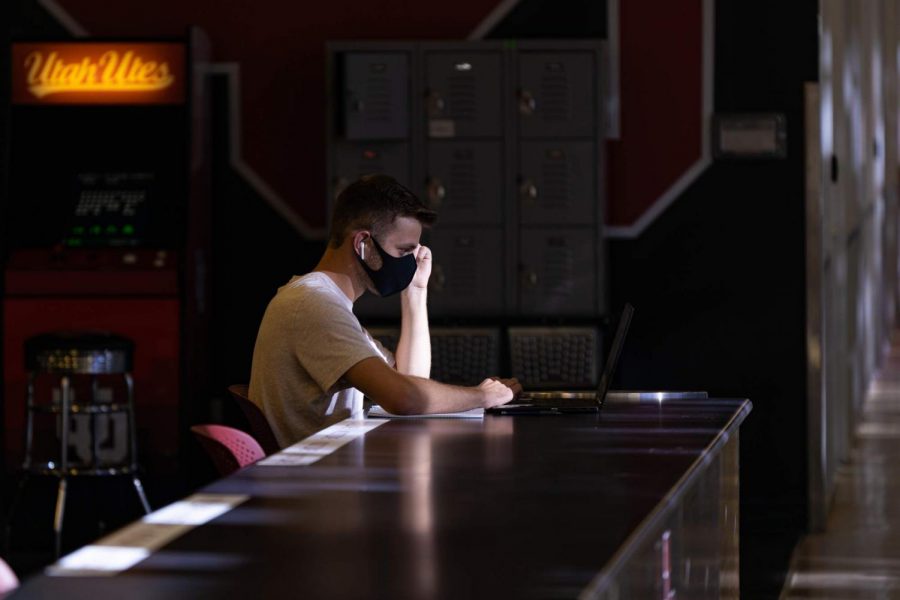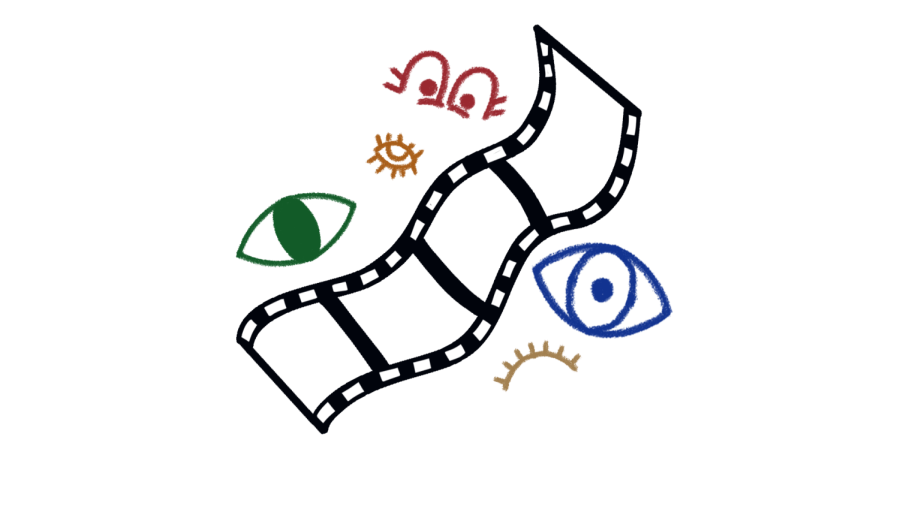Behind the Screen: The Effect of Online Instruction on Students and Faculty
A University of Utah student following the COVID-19 guidelines by a wearing mask while working on campus in September 2020. (Photo by Abu Asib | The Daily Utah Chronicle)
September 17, 2020
One of the things Professor Kimberley Mangun misses most since quarantining is her Zumba classes.
“I used to religiously take my exercise classes and that was something that I had on my calendar,” Mangun said. “I was committed to doing it because it was on my calendar, and I lost that with the pandemic… it’s really, really hard for me to replace that.”
Mangun, who is teaching an introductory news writing course and mass communication history class at the University of Utah this semester, had her last Zumba class on March 12, 2020. Mangun is only teaching virtually because of an autoimmune disease requiring rigorous adherence to quarantining.
“It has been really challenging,” Mangun said. “I mean, I think most faculty love being in the classroom. We love the interaction with students. We love being able to make those connections between a student’s lived experiences and class content. When you can’t see students, even if it’s virtual, in our case with the Zoom environment, that is at a distance, and for me personally, it’s been really weird to record lectures, for example, and only be staring at my green camera button.”
Since the beginning of June 2020, Mangun said she has been working on how to format her classes for the virtual platform, saying that it was important for students to recognize that faculty are struggling too.
“I’m also starting the semester, much, much further behind than I’ve started any semester,” Mangun said. “I do feel like I’m not doing a great job already with self-care because I’m already working so much.”
The U is currently in the Orange phase of the state color-coded health guidance system, meaning that there is a moderate risk for everyone except high-risk individuals for COVID-19.
According to the U’s coronavirus website, “extreme precautions” should be taken in this phase, including minimizing “in person in favor of virtual interactions”.
While most professors typically teach two courses per semester according to Mangun, Professor Tina Ziemek, a business and entrepreneurship instructor, took on three additional courses to her original workload and is now teaching seven due to in-person class size restrictions.
Because of unusually high Business Core enrollment this year, additional classes were added. Instead of five sections, BCOR classes were split in half and capped at 10 sections, along with becoming a hybrid course utilizing both online and in-person instruction. Ziemek only has one fully remote course.
Ziemek says that the workload is doable because content can be reused across her repeated courses. Without the reusability, Ziemek said, “there’s no way” she could teach the same amount.
“It’s not quadruple or quintuple the workload, but it is more face time in me going into the university more than I originally would have to accommodate the sheer number of students that we’re trying to make, if they want to have the in-person experience, to make that possible,” Ziemek said.
The BCOR section is an “integral part of students deciding whether or not they’ll be business majors,” according to Ziemek, which influenced the dean’s team in their decision to prioritize the in-person experience.
“One of the things that I teach in my own work in entrepreneurship is giving the best experience possible,” Ziemek said. “As an entrepreneur… what we do is we create value. And so that’s what I mean by that responsibility is well, I feel like I can create value. And some of these students are saying ‘hey, I need in-person courses, this is how you can create value for me.’ Then, as an entrepreneur, on that side of the lens I’m like well okay, that’s what they’re asking for. That’s what I’m going to do, and I see that perspective.”
While online instruction wasn’t every student’s or professor’s preferred method of instruction, some students have more experience than others with virtual platforms. Devin Dayley, communications major with journalism emphasis, has been taking online courses for three years to avoid a commute to campus from Utah County.
Now, Dayley lives in Salt Lake but says it’s hard to get to know people because of his strict quarantine. In 2012, Dayley had surgery for a cancerous brain tumor known as an astrocytoma. Since then, he’s been in remission.
Before the pandemic, Dayley said he preferred online instruction. Now, Dayley wants to go to campus and experience in-person classes, but that isn’t happening.
“[Online classes have] been a challenge more than before because a lot of classes were built to be in-person classes and so it’s hard to be online,” Dayley said.
Before the quarantine in March, Dayley wasn’t in school and found that his mental health took a toll.
“I know for me it was super easy to just lay around and not shower and whatnot. Once I started school, I did start to see a difference in my mental health and feeling productive,” Dayley said. “I wouldn’t necessarily say [quarantine] affected my schooling more than other people, but… I’m one who likes to get out frequently so it’s been really hard not to be out in the world and be social. It’s exhausting.”
Dayley said incorporating his schoolwork into his daily life helped him overcome the challenges posed by online classes. For Dayley, this looks like not working in his pajamas and putting assignments into his phone calendar.
Professor Mangun also emphasized the importance of a schedule, especially because “it’s just too easy to get sidetracked.” She suggests scheduling in class and homework time.
“What are you going to do to maintain that schedule? Because once you get off schedule and once you get behind, it’s going to be really, really difficult to get caught up again,” Mangun said. “My husband’s not working at home, but he’s been taking some time off to do some work around our house. I’m working at home and he’ll come in and he’ll ask me questions, and so I’ve really had to tell him like look, I’m home but I’m working right now. Please don’t bother me until lunchtime.”
Professor Ziemek said she had lots of students contacting her with logistical questions, and while she “would love to answer all these one on one,” Ziemek would rather use the time to discuss content.
“Much as you all don’t like to, you have to read thoroughly,” Ziemek said. “Read the announcements that your professors send out because if they’re sending out an announcement to the entire course, it’s important. You’d just be surprised how many students don’t even do that.”
Just like it’s easy to get distracted while working at home, Mangun also said that it was just as easy to be working all the time. Mangun’s department and college have been sending out resources for self-care.
The Center for Student Wellness offers wellness coaching for $15 for four sessions or $5 per session, with the first one free. The University Counseling Center offers individual, couple, and group counseling at varying rates. A more extensive list of resources can be found online.
“What I really appreciated that came kind of from the top [of the business school] was that not everything’s gonna be perfect and that we should pass that messaging down to the students,” Ziemek said.







